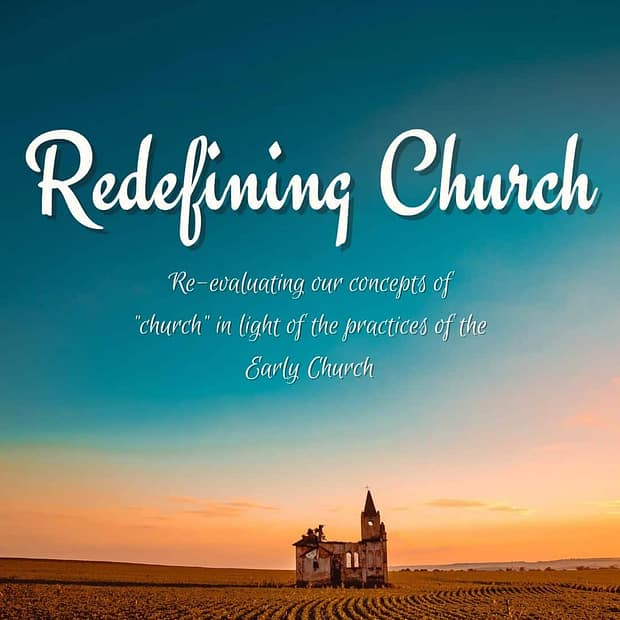Should we be redefining church and what it means in our society today? What can the earliest believers teach us about what it REALLY means to be a fellowship of believers?
The church in the 21st Century is in crisis. No longer at the forefront of communities, it struggles to make itself relevant and reach out to the lost and broken. The essence of what it really meant, for the very first Christ-followers, to be a church or a community of believers, has been lost in layers of rules and rituals. What would it mean for the church today to return to its roots, and shake off the centuries of dogma and doctrinal debate? How can we even begin the process of redefining church?
Read: Acts 2:42-47
All the believers devoted themselves to the apostles’ teaching, and to fellowship, and to sharing in meals (including the Lord’s Supper), and to prayer.
A deep sense of awe came over them all, and the apostles performed many miraculous signs and wonders. And all the believers met together in one place and shared everything they had. They sold their property and possessions and shared the money with those in need. They worshiped together at the Temple each day, met in homes for the Lord’s Supper, and shared their meals with great joy and generosity— all the while praising God and enjoying the goodwill of all the people. And each day the Lord added to their fellowship those who were being saved.
Acts 2 is, arguably, the record of the very beginning of what we would call the church. Those early believers wouldn’t necessarily have described themselves that way – the ekklesia was a term that only became familiar much later in church history. But as we understand it, they were the early church. Peter gave his first sermon on the day of Pentecost, and 3000 people received salvation. I don’t suppose there was a membership register (nor would there have been a need for one), and there was no statement of beliefs that these new believers had to read and agree to. They were embraced into the fellowship of believers simply by repenting and being baptized.
The Early Church vs. the Modern Church
In six verses at the end of Acts 2, we’re given a glimpse into the structure and the practices of this very first example of the church of Jesus Christ. It is a picture of a kind of fellowship and community and devotion to the Lord that, sadly, many of our modern conceptions of church fail to offer. Over two centuries of church history, the essence of what it means to be a fellowship of believers in Jesus Christ has been obscured by man-made rules, interpretations, and rituals. In striving to make the church better (or, some might argue, use it to control the people), the simplicity of how the church really began has been forgotten.
Where does that leave us? Should we be content to carry on with doing church in the ways that have become familiar to us, perhaps gathering once a week to sing a few songs, listen to a sermon and go home again having satisfied ourselves that the “church” box has been ticked until the next week? Should we be compliant with the rules and rituals that are nowhere to be found in our Bibles but have wormed their way into our churches just because “that’s the way it’s done here”, or should we be rethinking or redefining church so that we can return to the true roots of Christianity?
Do We Need to Redefine What We Understand About Church?
I’m going to put my neck on the line here and suggest that contentment and compliancy are the very last things we should be considering. It’s never easy to swim against the tide, but the question is, whose tide would we be swimming against? If we truly believe that “all Scripture is God-breathed”, as Paul wrote to Timothy, then the model of church that we should be following isn’t the ones that have become traditional or popular but the one that the Bible lays out for us.
We need to start redefining church if we want our churches to truly represent what Jesus intended for his bride to be. If we really want to understand what it means to be the bride of Christ, we need to strip back the layers of additions and bureaucracy and embrace the picture of the church that Acts 2:42-47 describes.
There are eight key principles contained within these six verses. Over the next eight posts, I’ll be unpacking each one of these and looking at how we might employ them in our lives in order to get back to the picture of the church that God ordained, thus redefining church in the 21st century.
“The church is not a select circle of the immaculate, but a home where the outcast may come in. It is not a palace with gate attendants and challenging sentinels along the entrance-ways holding off at arm’s-length the stranger, but rather a hospital where the broken-hearted may be healed, and where all the weary and troubled may find rest and take counsel together.”
– James H. Aughey

The Eight Concepts of Redefining Church
- Concept 1: Devotion to the Teaching of the Gospel of Jesus Christ
- Concept 2: Devoted to Fellowship
- Concept 3: Devotion to Breaking of Bread and Prayer
- Concept 4: Togetherness
- Concept 5: Real Community and Sharing
- Concept 6: All-Encompassing Faith
- Concept 7: With Glad and Sincere Hearts
- Concept 8: Praise God
